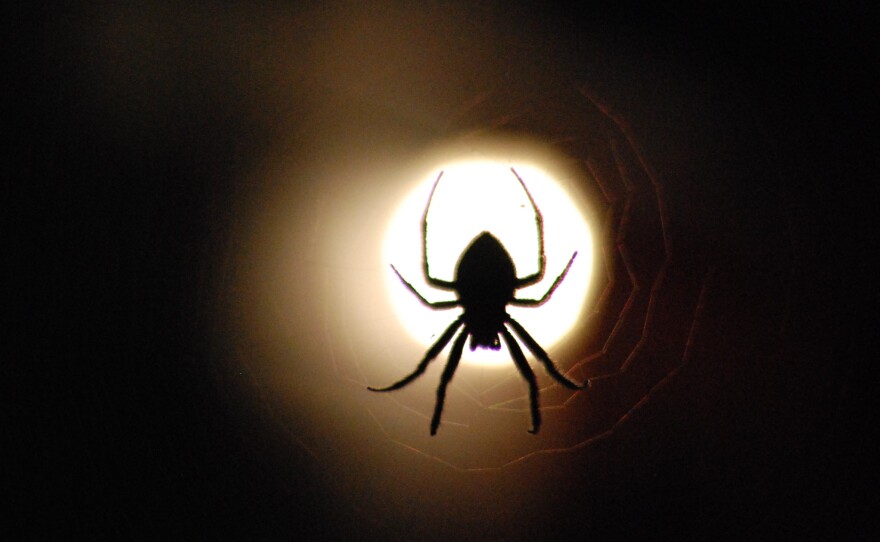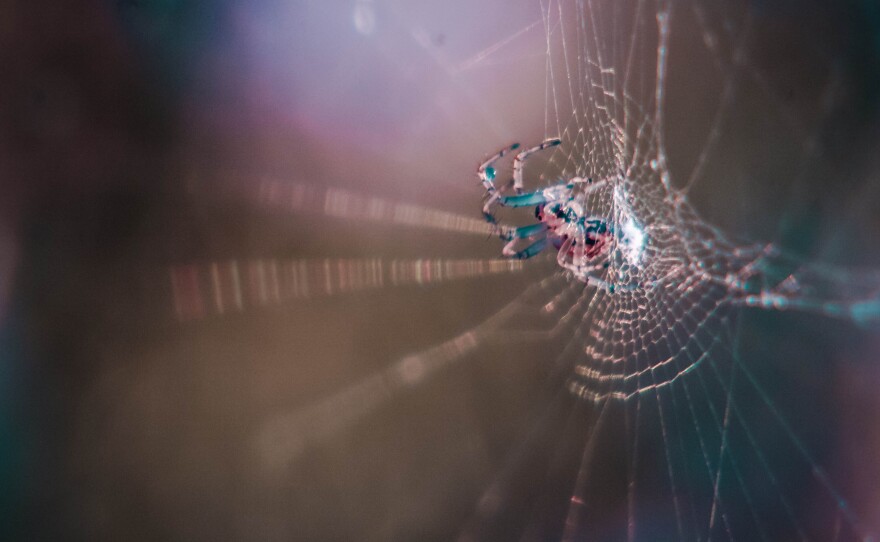Mention spiders, and many people shiver.
But a local researcher says they are nature’s most adept architects, spinning intricate webs from amazingly elastic material.
In this week’s Exploradio WKSU’s Jeff St.Clair reports on why the eight-legged arachnids deserve our respect.
We’re in the lab of University of Akron researcher Todd Blackledge.
I brought along some spiders in the hope that he can identify them. They don't pose much of a challenge.
“All right," says Blackledge, "you have three beautiful little spiders there," he says with the same warmth as if I had presented a box of kittens. "We’ve got what we sometimes call a daddy-long-leg spider," dubbed the spindly-legged spider by my family.
There’s also a small, shiny, brownish one, “the common house spider, " says Blackledge, known for its habit of leaving cobwebs in hard to reach places.
“It’s a spider that can be found all over the world because it’s so happy living in houses, barns, and garages…”
And there’s one more, a wolf spider, which unlike the other two was found outside of my house.

Blackledge isn’t at all squeamish as the spindly-legged spider crawls over his hand. It suddenly dives in a spider free-fall.
“You can see she’s going down on a little drag line as she drops.”
The attempted escape is a chance for Blackledge to talk about his favorite topic, spider silk.
“It’s the ultimate in green chemistry for high-performance fibers," he says.
"That silk thread she’s sailing to the floor on, that was being produced in milliseconds from a liquid feed stock that’s stored inside her body until it’s spun on demand into a silk thread that ounce for ounce can be five times stronger than steel.”
And for Blackledge, that’s the real magic of spiders. Their silk.
Beyond the breaking point
Blackledge is justifiably awed by spider silk's credentials as a super-biomaterial. He demonstrates how phenomenal an ordinary piece of silk can be by using a fancy sounding piece of equipment, "our nanobionics tensile testing system.”

Basically it tells him how strong the silk is.
Blackledge clips a nearly invisible section of spider drag line into the machine
“It’s about 2 microns thick,” he says, "around 100 times thinner than a human hair."
A graph appears on the computer as the test begins. “We’re pulling on the thread. You can see we’re generating more and more load. We’re up to Millinewtons now.”
The thread holds for a surprisingly long time. “Wait for it,” he says, right before it snaps.
“It takes a tremendous amount of work to break these silk threads," says Blackledge. "That’s what lets a tiny one or two micron fiber stop a flying insect.”
Spider silk the thickness of a pencil could theoretically stop a jet plane.
Stronger silk, better glue
Blackledge is one of the first to study the silk of a newly discovered spider from Madagascar – Darwin’s bark spider - which not only builds the largest webs in the world, it produces the strongest silk.
“So we just took nature’s toughest material, and found out it could actually be twice as good.”

Blackledge is also working with spider glue, the chemicals that make webs sticky.
“We’ve discovered spider species where their glues get better and better the more humid it gets," he says "so we’re interested in how their glue is leveraging humidity to produce increased stickiness.”
His discoveries are leading to adhesives that could be used in produce packaging and even bandages.
Commercial production of spider silk still eludes us, but Blackledge says, we’re close.
“There’re a bunch of companies right now that are working on different systems for producing these silk proteins at an industrial quantity.”
But he says the synthetic spider silk is still only half as strong as the real thing.
Our friend the black widow
Blackledge’s lab is home to dozens of black widow spiders, which is the spider of choice for researchers due to its mild temperament and ease of care.
He teases one out of its cardboard cave to give me a closer look. It's similar in shape to the common house spider, a distant relative, but much larger. I can see the tell-tale red hourglass on her abdomen.

He says while rare, black widows do live around here, although he's never seen one in the wild in Ohio. The ones in his lab are imported from California, where they're disturbingly common.
Only a handful of the more than 46,000 spider species in the world are, like the black widow, hazardous to humans. Blackledge feels our fear of them is wildly overblown.
“That’s a very cultural thing," he says. "We grow up in Western society being taught that spiders are creepy and kind of sinister. If you grew up in western Africa or in some Native American cultures then spiders are revered as being clever and industrious, building these amazing webs.”
Science has shown that even if we don’t love spiders, they deserve our admiration.








